Resource Based Strategies and Implementing Strategies and Managing Change
VerifiedAdded on 2023/06/09
|11
|2453
|480
AI Summary
This report discusses resource based strategies and how they can be used to develop a competitive edge. It also covers implementing strategies and managing change, including the role of leadership and vision in the process. The report emphasizes the importance of effective implementation of strategies and the need for good leadership to cope with changes.
Contribute Materials
Your contribution can guide someone’s learning journey. Share your
documents today.
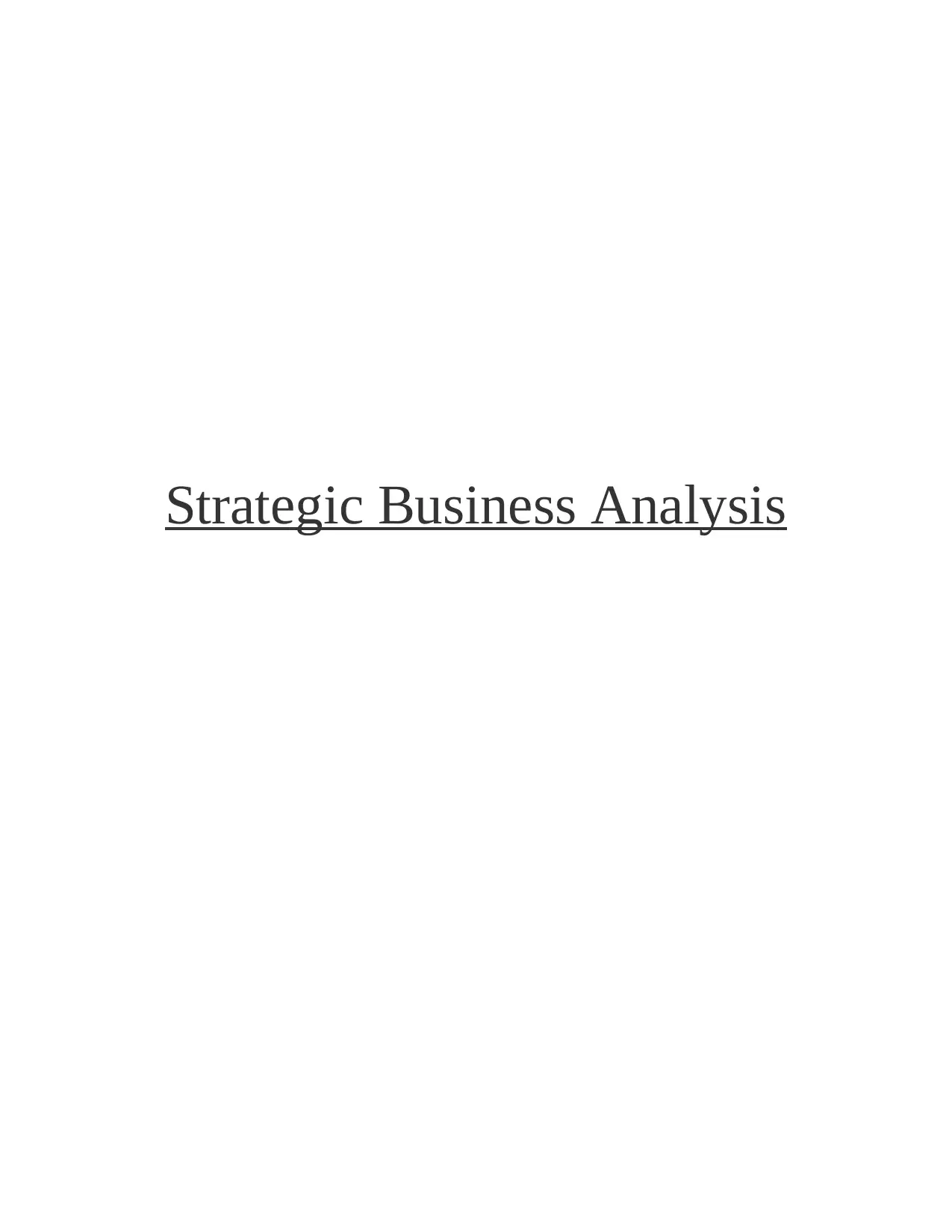
Strategic Business Analysis
Secure Best Marks with AI Grader
Need help grading? Try our AI Grader for instant feedback on your assignments.

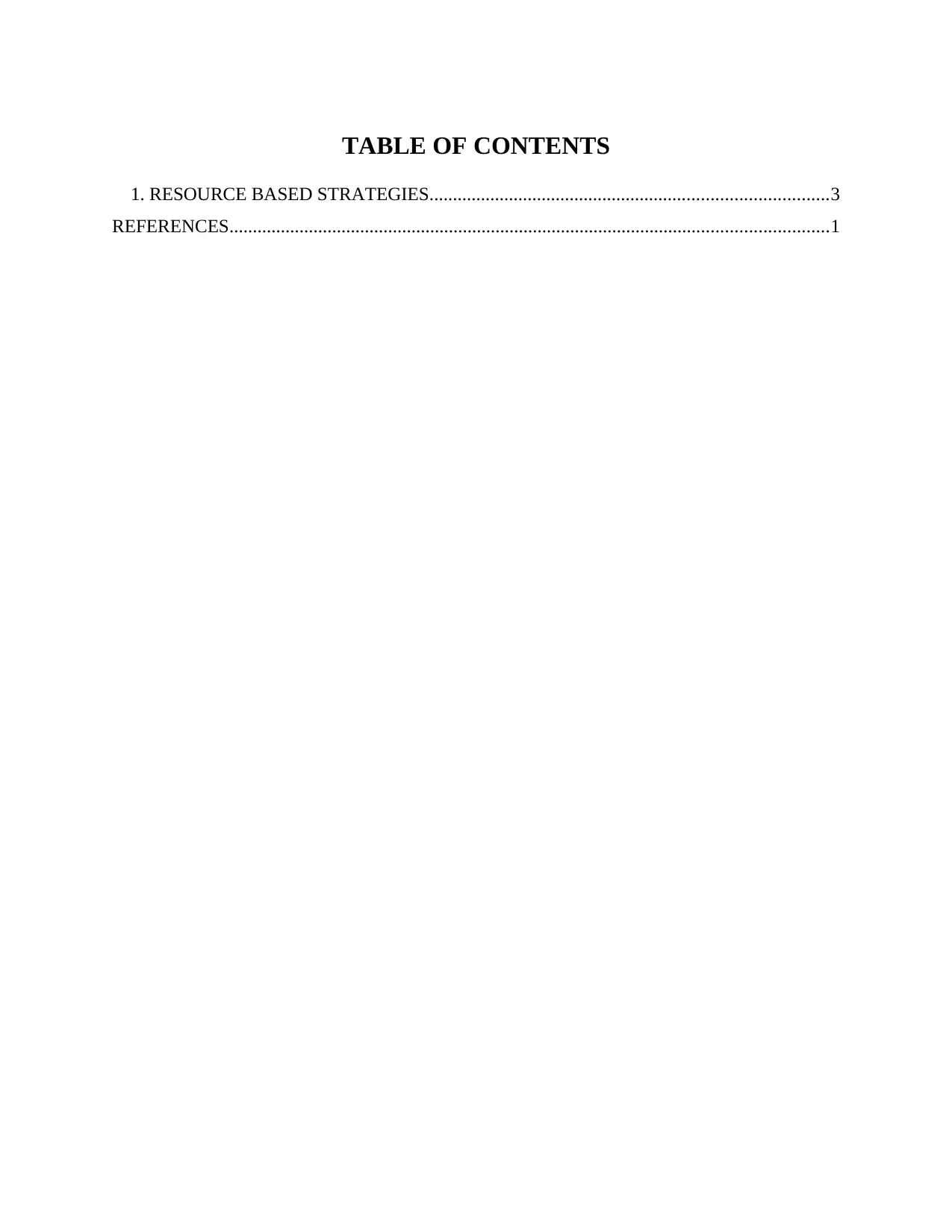
TABLE OF CONTENTS
1. RESOURCE BASED STRATEGIES.....................................................................................3
REFERENCES................................................................................................................................1
1. RESOURCE BASED STRATEGIES.....................................................................................3
REFERENCES................................................................................................................................1
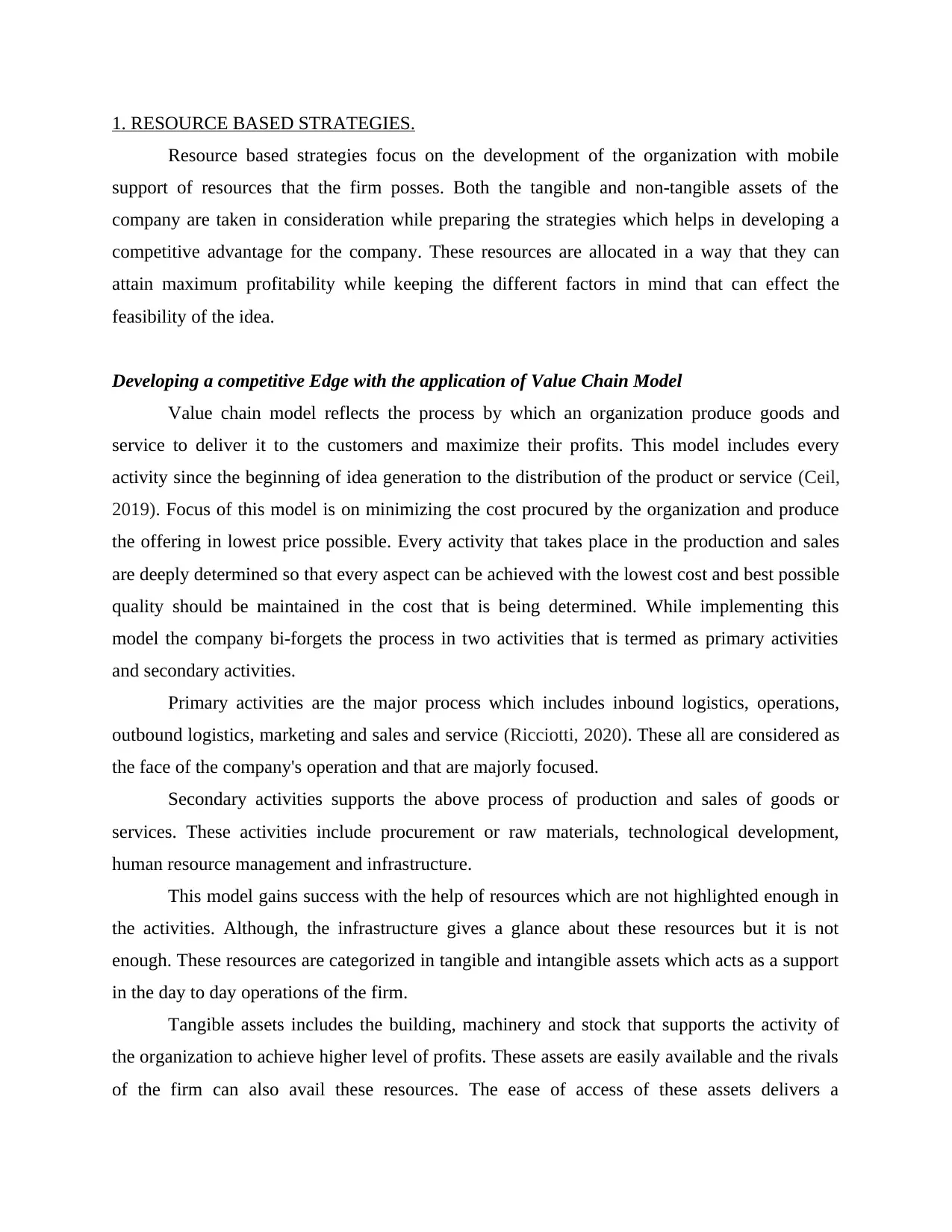
1. RESOURCE BASED STRATEGIES.
Resource based strategies focus on the development of the organization with mobile
support of resources that the firm posses. Both the tangible and non-tangible assets of the
company are taken in consideration while preparing the strategies which helps in developing a
competitive advantage for the company. These resources are allocated in a way that they can
attain maximum profitability while keeping the different factors in mind that can effect the
feasibility of the idea.
Developing a competitive Edge with the application of Value Chain Model
Value chain model reflects the process by which an organization produce goods and
service to deliver it to the customers and maximize their profits. This model includes every
activity since the beginning of idea generation to the distribution of the product or service (Ceil,
2019). Focus of this model is on minimizing the cost procured by the organization and produce
the offering in lowest price possible. Every activity that takes place in the production and sales
are deeply determined so that every aspect can be achieved with the lowest cost and best possible
quality should be maintained in the cost that is being determined. While implementing this
model the company bi-forgets the process in two activities that is termed as primary activities
and secondary activities.
Primary activities are the major process which includes inbound logistics, operations,
outbound logistics, marketing and sales and service (Ricciotti, 2020). These all are considered as
the face of the company's operation and that are majorly focused.
Secondary activities supports the above process of production and sales of goods or
services. These activities include procurement or raw materials, technological development,
human resource management and infrastructure.
This model gains success with the help of resources which are not highlighted enough in
the activities. Although, the infrastructure gives a glance about these resources but it is not
enough. These resources are categorized in tangible and intangible assets which acts as a support
in the day to day operations of the firm.
Tangible assets includes the building, machinery and stock that supports the activity of
the organization to achieve higher level of profits. These assets are easily available and the rivals
of the firm can also avail these resources. The ease of access of these assets delivers a
Resource based strategies focus on the development of the organization with mobile
support of resources that the firm posses. Both the tangible and non-tangible assets of the
company are taken in consideration while preparing the strategies which helps in developing a
competitive advantage for the company. These resources are allocated in a way that they can
attain maximum profitability while keeping the different factors in mind that can effect the
feasibility of the idea.
Developing a competitive Edge with the application of Value Chain Model
Value chain model reflects the process by which an organization produce goods and
service to deliver it to the customers and maximize their profits. This model includes every
activity since the beginning of idea generation to the distribution of the product or service (Ceil,
2019). Focus of this model is on minimizing the cost procured by the organization and produce
the offering in lowest price possible. Every activity that takes place in the production and sales
are deeply determined so that every aspect can be achieved with the lowest cost and best possible
quality should be maintained in the cost that is being determined. While implementing this
model the company bi-forgets the process in two activities that is termed as primary activities
and secondary activities.
Primary activities are the major process which includes inbound logistics, operations,
outbound logistics, marketing and sales and service (Ricciotti, 2020). These all are considered as
the face of the company's operation and that are majorly focused.
Secondary activities supports the above process of production and sales of goods or
services. These activities include procurement or raw materials, technological development,
human resource management and infrastructure.
This model gains success with the help of resources which are not highlighted enough in
the activities. Although, the infrastructure gives a glance about these resources but it is not
enough. These resources are categorized in tangible and intangible assets which acts as a support
in the day to day operations of the firm.
Tangible assets includes the building, machinery and stock that supports the activity of
the organization to achieve higher level of profits. These assets are easily available and the rivals
of the firm can also avail these resources. The ease of access of these assets delivers a
Secure Best Marks with AI Grader
Need help grading? Try our AI Grader for instant feedback on your assignments.
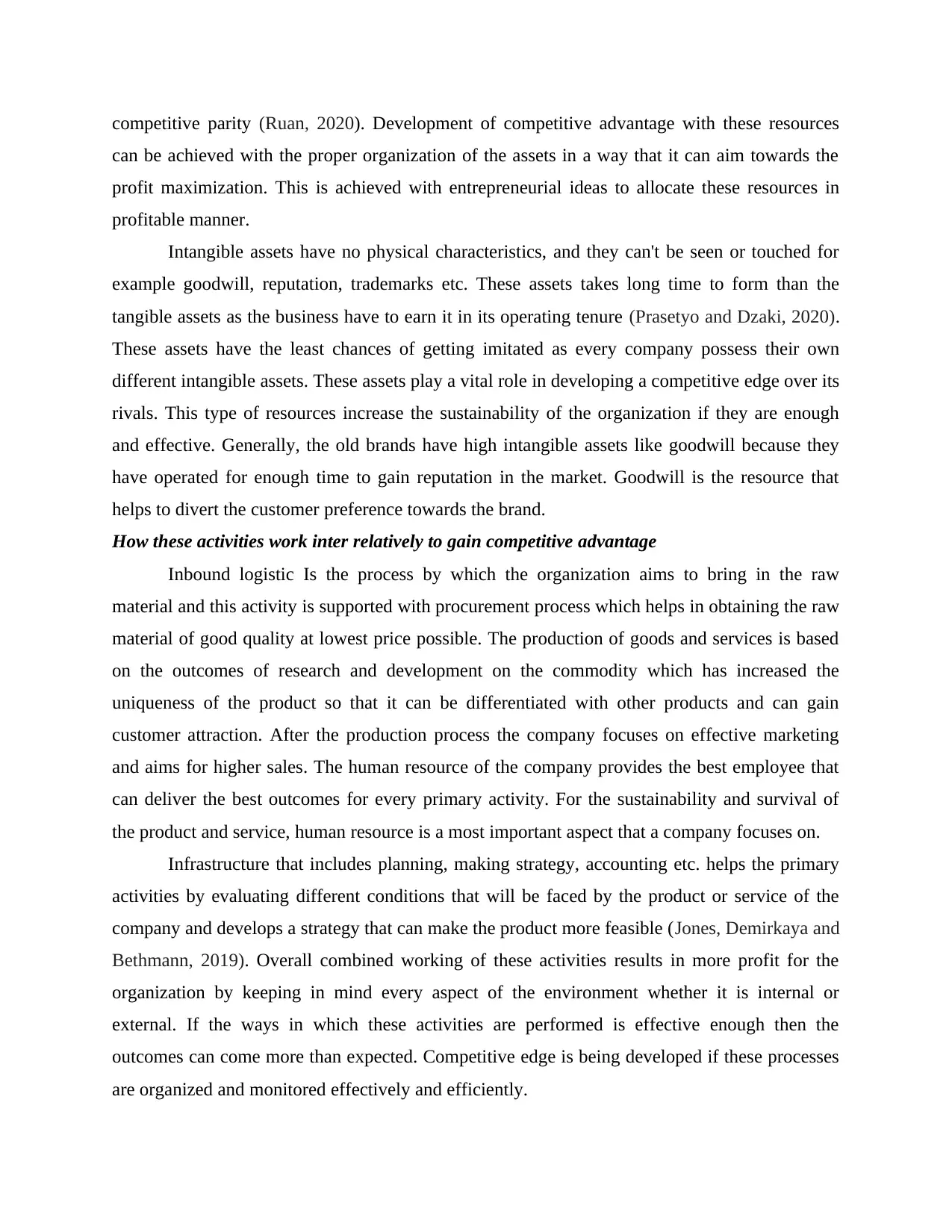
competitive parity (Ruan, 2020). Development of competitive advantage with these resources
can be achieved with the proper organization of the assets in a way that it can aim towards the
profit maximization. This is achieved with entrepreneurial ideas to allocate these resources in
profitable manner.
Intangible assets have no physical characteristics, and they can't be seen or touched for
example goodwill, reputation, trademarks etc. These assets takes long time to form than the
tangible assets as the business have to earn it in its operating tenure (Prasetyo and Dzaki, 2020).
These assets have the least chances of getting imitated as every company possess their own
different intangible assets. These assets play a vital role in developing a competitive edge over its
rivals. This type of resources increase the sustainability of the organization if they are enough
and effective. Generally, the old brands have high intangible assets like goodwill because they
have operated for enough time to gain reputation in the market. Goodwill is the resource that
helps to divert the customer preference towards the brand.
How these activities work inter relatively to gain competitive advantage
Inbound logistic Is the process by which the organization aims to bring in the raw
material and this activity is supported with procurement process which helps in obtaining the raw
material of good quality at lowest price possible. The production of goods and services is based
on the outcomes of research and development on the commodity which has increased the
uniqueness of the product so that it can be differentiated with other products and can gain
customer attraction. After the production process the company focuses on effective marketing
and aims for higher sales. The human resource of the company provides the best employee that
can deliver the best outcomes for every primary activity. For the sustainability and survival of
the product and service, human resource is a most important aspect that a company focuses on.
Infrastructure that includes planning, making strategy, accounting etc. helps the primary
activities by evaluating different conditions that will be faced by the product or service of the
company and develops a strategy that can make the product more feasible (Jones, Demirkaya and
Bethmann, 2019). Overall combined working of these activities results in more profit for the
organization by keeping in mind every aspect of the environment whether it is internal or
external. If the ways in which these activities are performed is effective enough then the
outcomes can come more than expected. Competitive edge is being developed if these processes
are organized and monitored effectively and efficiently.
can be achieved with the proper organization of the assets in a way that it can aim towards the
profit maximization. This is achieved with entrepreneurial ideas to allocate these resources in
profitable manner.
Intangible assets have no physical characteristics, and they can't be seen or touched for
example goodwill, reputation, trademarks etc. These assets takes long time to form than the
tangible assets as the business have to earn it in its operating tenure (Prasetyo and Dzaki, 2020).
These assets have the least chances of getting imitated as every company possess their own
different intangible assets. These assets play a vital role in developing a competitive edge over its
rivals. This type of resources increase the sustainability of the organization if they are enough
and effective. Generally, the old brands have high intangible assets like goodwill because they
have operated for enough time to gain reputation in the market. Goodwill is the resource that
helps to divert the customer preference towards the brand.
How these activities work inter relatively to gain competitive advantage
Inbound logistic Is the process by which the organization aims to bring in the raw
material and this activity is supported with procurement process which helps in obtaining the raw
material of good quality at lowest price possible. The production of goods and services is based
on the outcomes of research and development on the commodity which has increased the
uniqueness of the product so that it can be differentiated with other products and can gain
customer attraction. After the production process the company focuses on effective marketing
and aims for higher sales. The human resource of the company provides the best employee that
can deliver the best outcomes for every primary activity. For the sustainability and survival of
the product and service, human resource is a most important aspect that a company focuses on.
Infrastructure that includes planning, making strategy, accounting etc. helps the primary
activities by evaluating different conditions that will be faced by the product or service of the
company and develops a strategy that can make the product more feasible (Jones, Demirkaya and
Bethmann, 2019). Overall combined working of these activities results in more profit for the
organization by keeping in mind every aspect of the environment whether it is internal or
external. If the ways in which these activities are performed is effective enough then the
outcomes can come more than expected. Competitive edge is being developed if these processes
are organized and monitored effectively and efficiently.
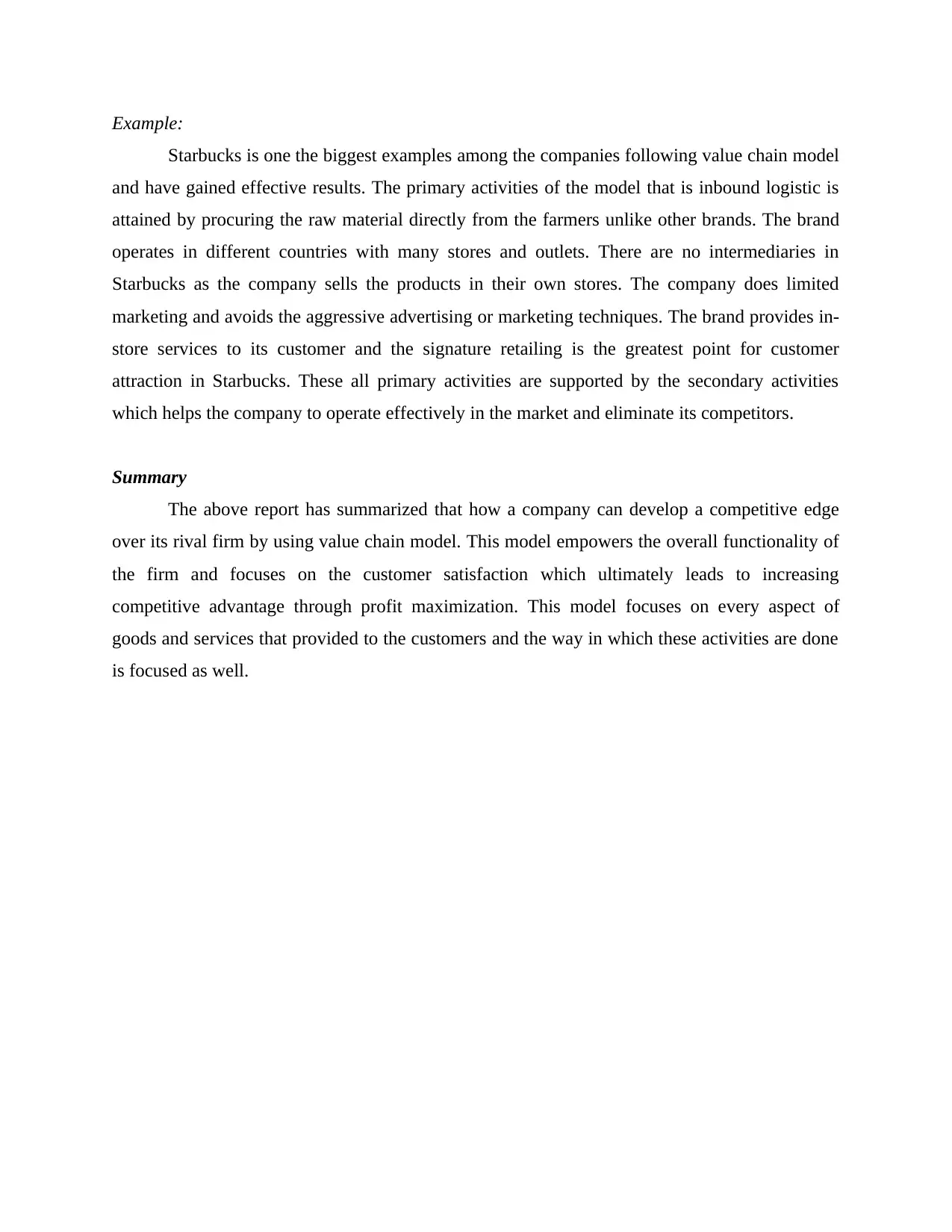
Example:
Starbucks is one the biggest examples among the companies following value chain model
and have gained effective results. The primary activities of the model that is inbound logistic is
attained by procuring the raw material directly from the farmers unlike other brands. The brand
operates in different countries with many stores and outlets. There are no intermediaries in
Starbucks as the company sells the products in their own stores. The company does limited
marketing and avoids the aggressive advertising or marketing techniques. The brand provides in-
store services to its customer and the signature retailing is the greatest point for customer
attraction in Starbucks. These all primary activities are supported by the secondary activities
which helps the company to operate effectively in the market and eliminate its competitors.
Summary
The above report has summarized that how a company can develop a competitive edge
over its rival firm by using value chain model. This model empowers the overall functionality of
the firm and focuses on the customer satisfaction which ultimately leads to increasing
competitive advantage through profit maximization. This model focuses on every aspect of
goods and services that provided to the customers and the way in which these activities are done
is focused as well.
Starbucks is one the biggest examples among the companies following value chain model
and have gained effective results. The primary activities of the model that is inbound logistic is
attained by procuring the raw material directly from the farmers unlike other brands. The brand
operates in different countries with many stores and outlets. There are no intermediaries in
Starbucks as the company sells the products in their own stores. The company does limited
marketing and avoids the aggressive advertising or marketing techniques. The brand provides in-
store services to its customer and the signature retailing is the greatest point for customer
attraction in Starbucks. These all primary activities are supported by the secondary activities
which helps the company to operate effectively in the market and eliminate its competitors.
Summary
The above report has summarized that how a company can develop a competitive edge
over its rival firm by using value chain model. This model empowers the overall functionality of
the firm and focuses on the customer satisfaction which ultimately leads to increasing
competitive advantage through profit maximization. This model focuses on every aspect of
goods and services that provided to the customers and the way in which these activities are done
is focused as well.
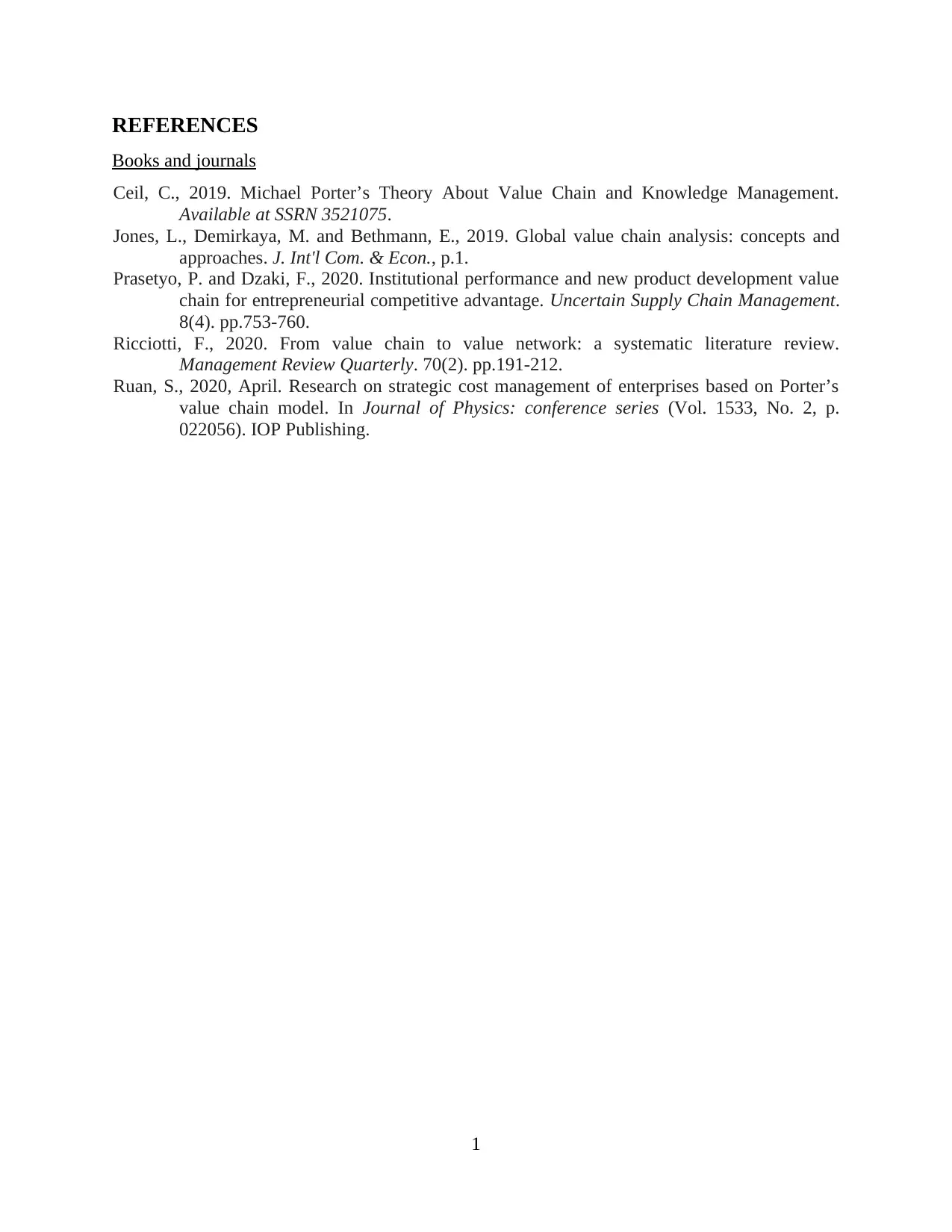
REFERENCES
Books and journals
Ceil, C., 2019. Michael Porter’s Theory About Value Chain and Knowledge Management.
Available at SSRN 3521075.
Jones, L., Demirkaya, M. and Bethmann, E., 2019. Global value chain analysis: concepts and
approaches. J. Int'l Com. & Econ., p.1.
Prasetyo, P. and Dzaki, F., 2020. Institutional performance and new product development value
chain for entrepreneurial competitive advantage. Uncertain Supply Chain Management.
8(4). pp.753-760.
Ricciotti, F., 2020. From value chain to value network: a systematic literature review.
Management Review Quarterly. 70(2). pp.191-212.
Ruan, S., 2020, April. Research on strategic cost management of enterprises based on Porter’s
value chain model. In Journal of Physics: conference series (Vol. 1533, No. 2, p.
022056). IOP Publishing.
1
Books and journals
Ceil, C., 2019. Michael Porter’s Theory About Value Chain and Knowledge Management.
Available at SSRN 3521075.
Jones, L., Demirkaya, M. and Bethmann, E., 2019. Global value chain analysis: concepts and
approaches. J. Int'l Com. & Econ., p.1.
Prasetyo, P. and Dzaki, F., 2020. Institutional performance and new product development value
chain for entrepreneurial competitive advantage. Uncertain Supply Chain Management.
8(4). pp.753-760.
Ricciotti, F., 2020. From value chain to value network: a systematic literature review.
Management Review Quarterly. 70(2). pp.191-212.
Ruan, S., 2020, April. Research on strategic cost management of enterprises based on Porter’s
value chain model. In Journal of Physics: conference series (Vol. 1533, No. 2, p.
022056). IOP Publishing.
1
Paraphrase This Document
Need a fresh take? Get an instant paraphrase of this document with our AI Paraphraser
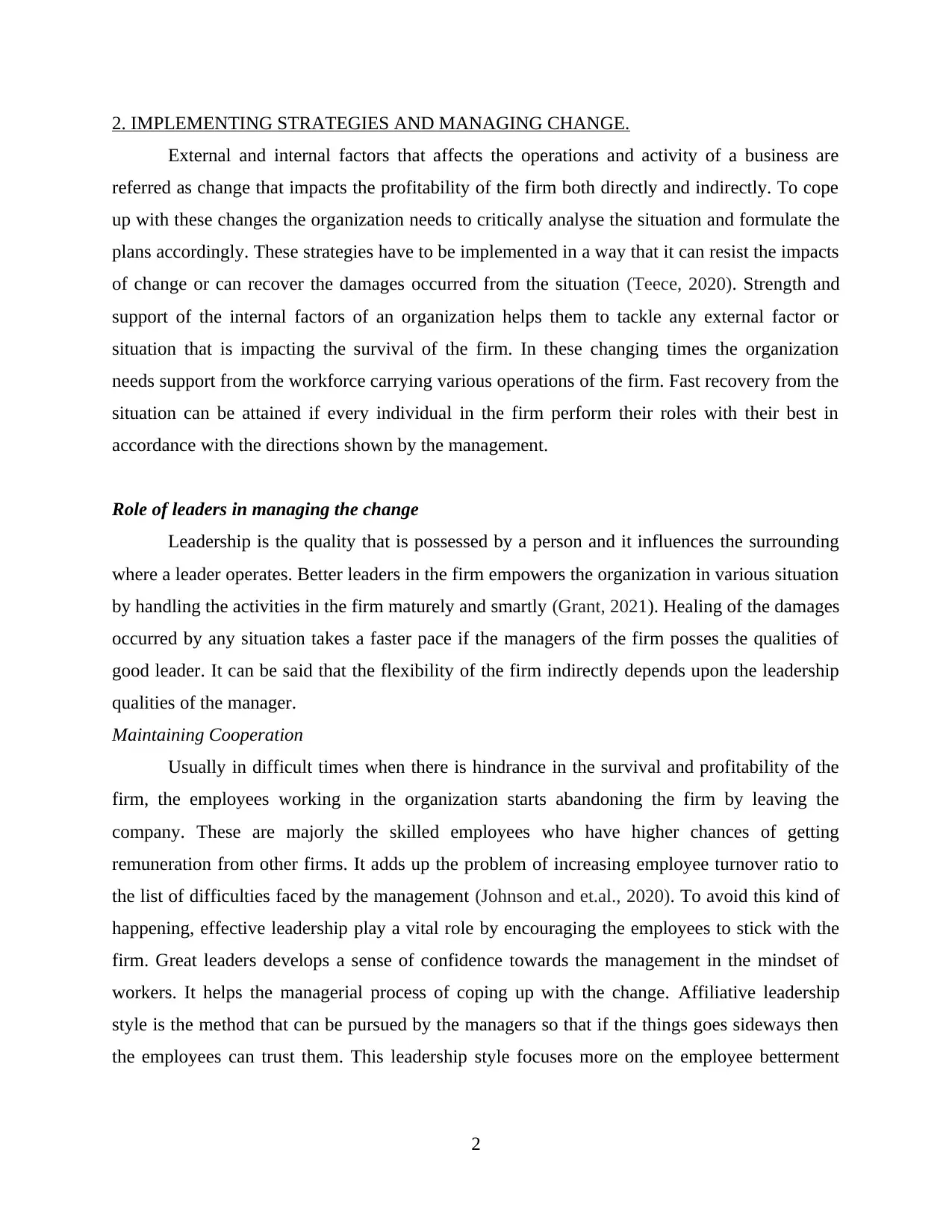
2. IMPLEMENTING STRATEGIES AND MANAGING CHANGE.
External and internal factors that affects the operations and activity of a business are
referred as change that impacts the profitability of the firm both directly and indirectly. To cope
up with these changes the organization needs to critically analyse the situation and formulate the
plans accordingly. These strategies have to be implemented in a way that it can resist the impacts
of change or can recover the damages occurred from the situation (Teece, 2020). Strength and
support of the internal factors of an organization helps them to tackle any external factor or
situation that is impacting the survival of the firm. In these changing times the organization
needs support from the workforce carrying various operations of the firm. Fast recovery from the
situation can be attained if every individual in the firm perform their roles with their best in
accordance with the directions shown by the management.
Role of leaders in managing the change
Leadership is the quality that is possessed by a person and it influences the surrounding
where a leader operates. Better leaders in the firm empowers the organization in various situation
by handling the activities in the firm maturely and smartly (Grant, 2021). Healing of the damages
occurred by any situation takes a faster pace if the managers of the firm posses the qualities of
good leader. It can be said that the flexibility of the firm indirectly depends upon the leadership
qualities of the manager.
Maintaining Cooperation
Usually in difficult times when there is hindrance in the survival and profitability of the
firm, the employees working in the organization starts abandoning the firm by leaving the
company. These are majorly the skilled employees who have higher chances of getting
remuneration from other firms. It adds up the problem of increasing employee turnover ratio to
the list of difficulties faced by the management (Johnson and et.al., 2020). To avoid this kind of
happening, effective leadership play a vital role by encouraging the employees to stick with the
firm. Great leaders develops a sense of confidence towards the management in the mindset of
workers. It helps the managerial process of coping up with the change. Affiliative leadership
style is the method that can be pursued by the managers so that if the things goes sideways then
the employees can trust them. This leadership style focuses more on the employee betterment
2
External and internal factors that affects the operations and activity of a business are
referred as change that impacts the profitability of the firm both directly and indirectly. To cope
up with these changes the organization needs to critically analyse the situation and formulate the
plans accordingly. These strategies have to be implemented in a way that it can resist the impacts
of change or can recover the damages occurred from the situation (Teece, 2020). Strength and
support of the internal factors of an organization helps them to tackle any external factor or
situation that is impacting the survival of the firm. In these changing times the organization
needs support from the workforce carrying various operations of the firm. Fast recovery from the
situation can be attained if every individual in the firm perform their roles with their best in
accordance with the directions shown by the management.
Role of leaders in managing the change
Leadership is the quality that is possessed by a person and it influences the surrounding
where a leader operates. Better leaders in the firm empowers the organization in various situation
by handling the activities in the firm maturely and smartly (Grant, 2021). Healing of the damages
occurred by any situation takes a faster pace if the managers of the firm posses the qualities of
good leader. It can be said that the flexibility of the firm indirectly depends upon the leadership
qualities of the manager.
Maintaining Cooperation
Usually in difficult times when there is hindrance in the survival and profitability of the
firm, the employees working in the organization starts abandoning the firm by leaving the
company. These are majorly the skilled employees who have higher chances of getting
remuneration from other firms. It adds up the problem of increasing employee turnover ratio to
the list of difficulties faced by the management (Johnson and et.al., 2020). To avoid this kind of
happening, effective leadership play a vital role by encouraging the employees to stick with the
firm. Great leaders develops a sense of confidence towards the management in the mindset of
workers. It helps the managerial process of coping up with the change. Affiliative leadership
style is the method that can be pursued by the managers so that if the things goes sideways then
the employees can trust them. This leadership style focuses more on the employee betterment
2
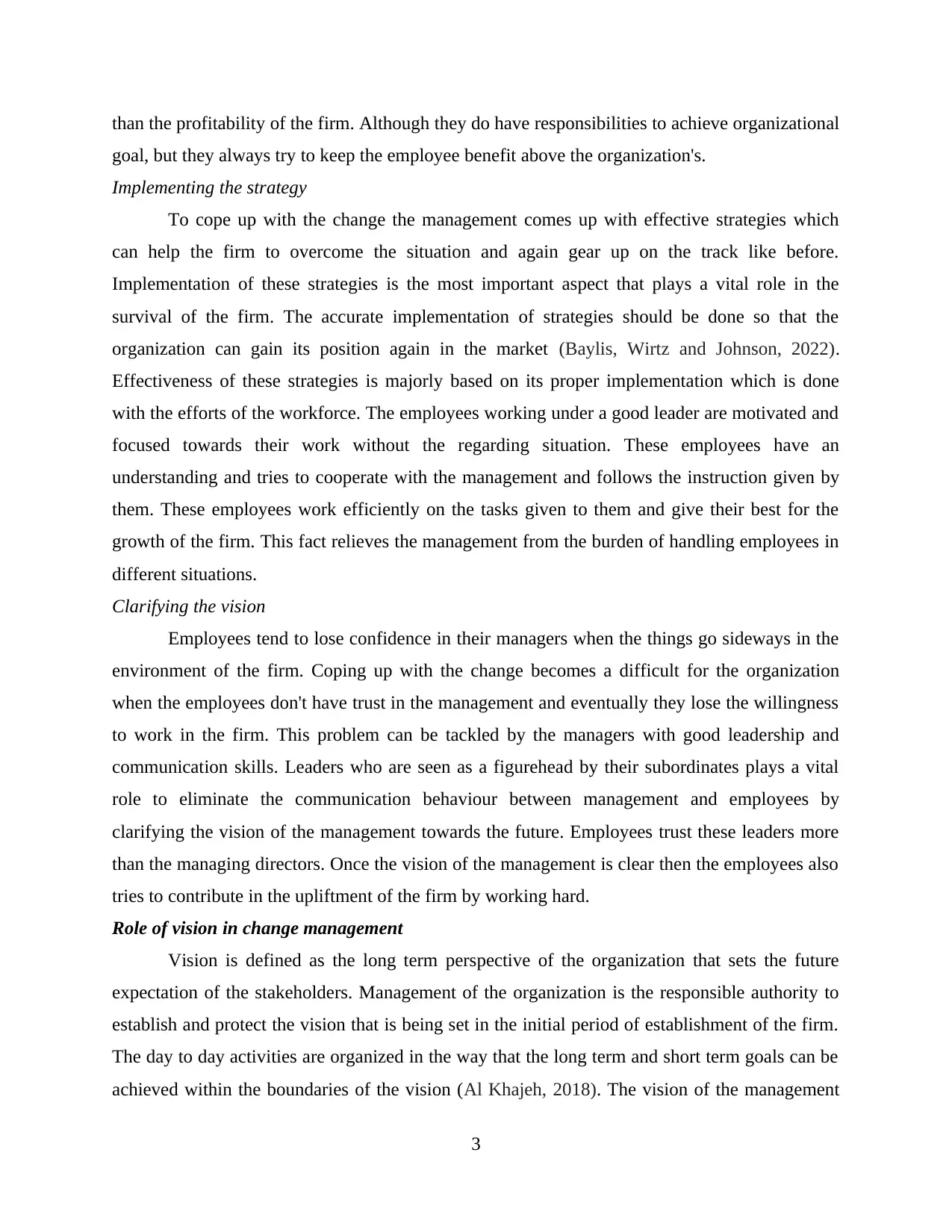
than the profitability of the firm. Although they do have responsibilities to achieve organizational
goal, but they always try to keep the employee benefit above the organization's.
Implementing the strategy
To cope up with the change the management comes up with effective strategies which
can help the firm to overcome the situation and again gear up on the track like before.
Implementation of these strategies is the most important aspect that plays a vital role in the
survival of the firm. The accurate implementation of strategies should be done so that the
organization can gain its position again in the market (Baylis, Wirtz and Johnson, 2022).
Effectiveness of these strategies is majorly based on its proper implementation which is done
with the efforts of the workforce. The employees working under a good leader are motivated and
focused towards their work without the regarding situation. These employees have an
understanding and tries to cooperate with the management and follows the instruction given by
them. These employees work efficiently on the tasks given to them and give their best for the
growth of the firm. This fact relieves the management from the burden of handling employees in
different situations.
Clarifying the vision
Employees tend to lose confidence in their managers when the things go sideways in the
environment of the firm. Coping up with the change becomes a difficult for the organization
when the employees don't have trust in the management and eventually they lose the willingness
to work in the firm. This problem can be tackled by the managers with good leadership and
communication skills. Leaders who are seen as a figurehead by their subordinates plays a vital
role to eliminate the communication behaviour between management and employees by
clarifying the vision of the management towards the future. Employees trust these leaders more
than the managing directors. Once the vision of the management is clear then the employees also
tries to contribute in the upliftment of the firm by working hard.
Role of vision in change management
Vision is defined as the long term perspective of the organization that sets the future
expectation of the stakeholders. Management of the organization is the responsible authority to
establish and protect the vision that is being set in the initial period of establishment of the firm.
The day to day activities are organized in the way that the long term and short term goals can be
achieved within the boundaries of the vision (Al Khajeh, 2018). The vision of the management
3
goal, but they always try to keep the employee benefit above the organization's.
Implementing the strategy
To cope up with the change the management comes up with effective strategies which
can help the firm to overcome the situation and again gear up on the track like before.
Implementation of these strategies is the most important aspect that plays a vital role in the
survival of the firm. The accurate implementation of strategies should be done so that the
organization can gain its position again in the market (Baylis, Wirtz and Johnson, 2022).
Effectiveness of these strategies is majorly based on its proper implementation which is done
with the efforts of the workforce. The employees working under a good leader are motivated and
focused towards their work without the regarding situation. These employees have an
understanding and tries to cooperate with the management and follows the instruction given by
them. These employees work efficiently on the tasks given to them and give their best for the
growth of the firm. This fact relieves the management from the burden of handling employees in
different situations.
Clarifying the vision
Employees tend to lose confidence in their managers when the things go sideways in the
environment of the firm. Coping up with the change becomes a difficult for the organization
when the employees don't have trust in the management and eventually they lose the willingness
to work in the firm. This problem can be tackled by the managers with good leadership and
communication skills. Leaders who are seen as a figurehead by their subordinates plays a vital
role to eliminate the communication behaviour between management and employees by
clarifying the vision of the management towards the future. Employees trust these leaders more
than the managing directors. Once the vision of the management is clear then the employees also
tries to contribute in the upliftment of the firm by working hard.
Role of vision in change management
Vision is defined as the long term perspective of the organization that sets the future
expectation of the stakeholders. Management of the organization is the responsible authority to
establish and protect the vision that is being set in the initial period of establishment of the firm.
The day to day activities are organized in the way that the long term and short term goals can be
achieved within the boundaries of the vision (Al Khajeh, 2018). The vision of the management
3
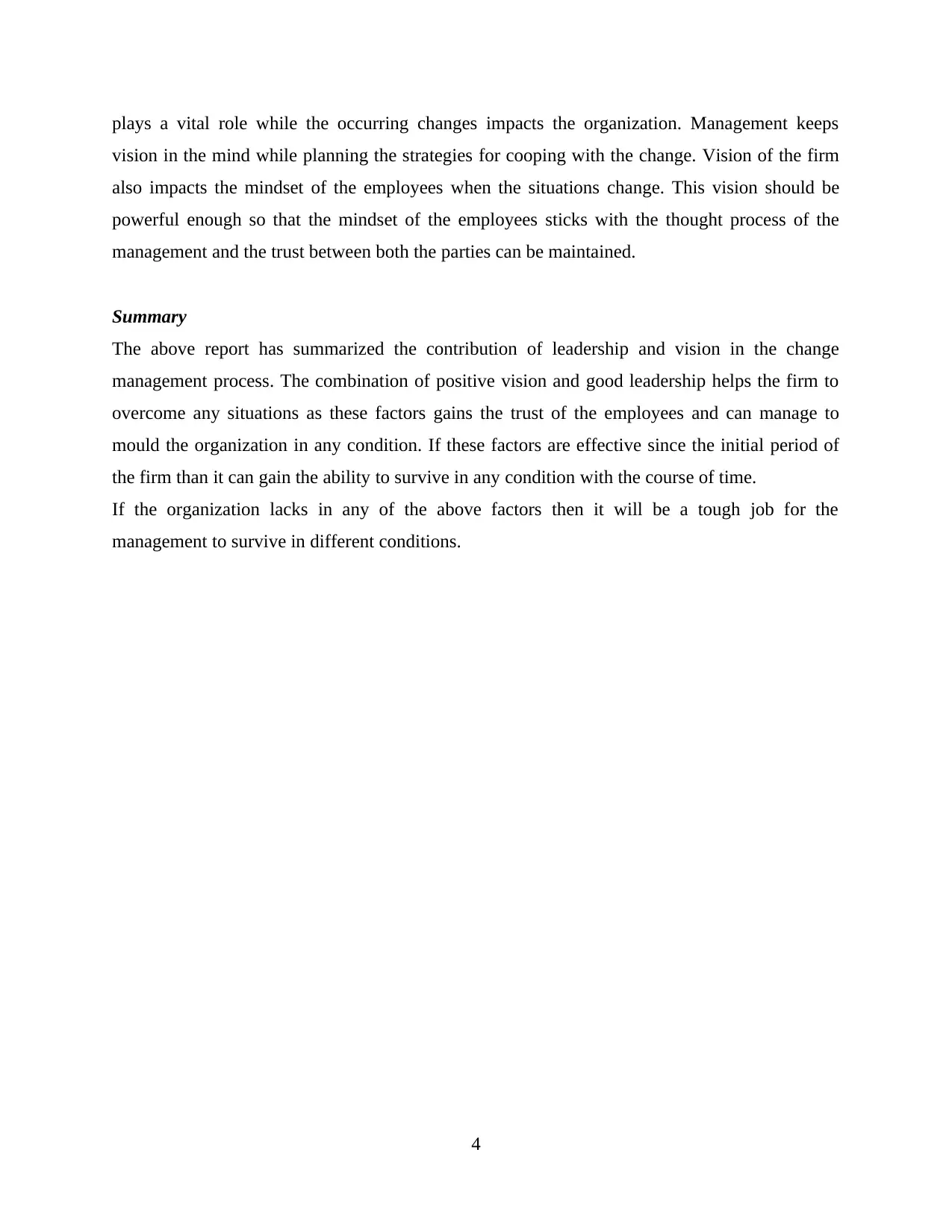
plays a vital role while the occurring changes impacts the organization. Management keeps
vision in the mind while planning the strategies for cooping with the change. Vision of the firm
also impacts the mindset of the employees when the situations change. This vision should be
powerful enough so that the mindset of the employees sticks with the thought process of the
management and the trust between both the parties can be maintained.
Summary
The above report has summarized the contribution of leadership and vision in the change
management process. The combination of positive vision and good leadership helps the firm to
overcome any situations as these factors gains the trust of the employees and can manage to
mould the organization in any condition. If these factors are effective since the initial period of
the firm than it can gain the ability to survive in any condition with the course of time.
If the organization lacks in any of the above factors then it will be a tough job for the
management to survive in different conditions.
4
vision in the mind while planning the strategies for cooping with the change. Vision of the firm
also impacts the mindset of the employees when the situations change. This vision should be
powerful enough so that the mindset of the employees sticks with the thought process of the
management and the trust between both the parties can be maintained.
Summary
The above report has summarized the contribution of leadership and vision in the change
management process. The combination of positive vision and good leadership helps the firm to
overcome any situations as these factors gains the trust of the employees and can manage to
mould the organization in any condition. If these factors are effective since the initial period of
the firm than it can gain the ability to survive in any condition with the course of time.
If the organization lacks in any of the above factors then it will be a tough job for the
management to survive in different conditions.
4
Secure Best Marks with AI Grader
Need help grading? Try our AI Grader for instant feedback on your assignments.
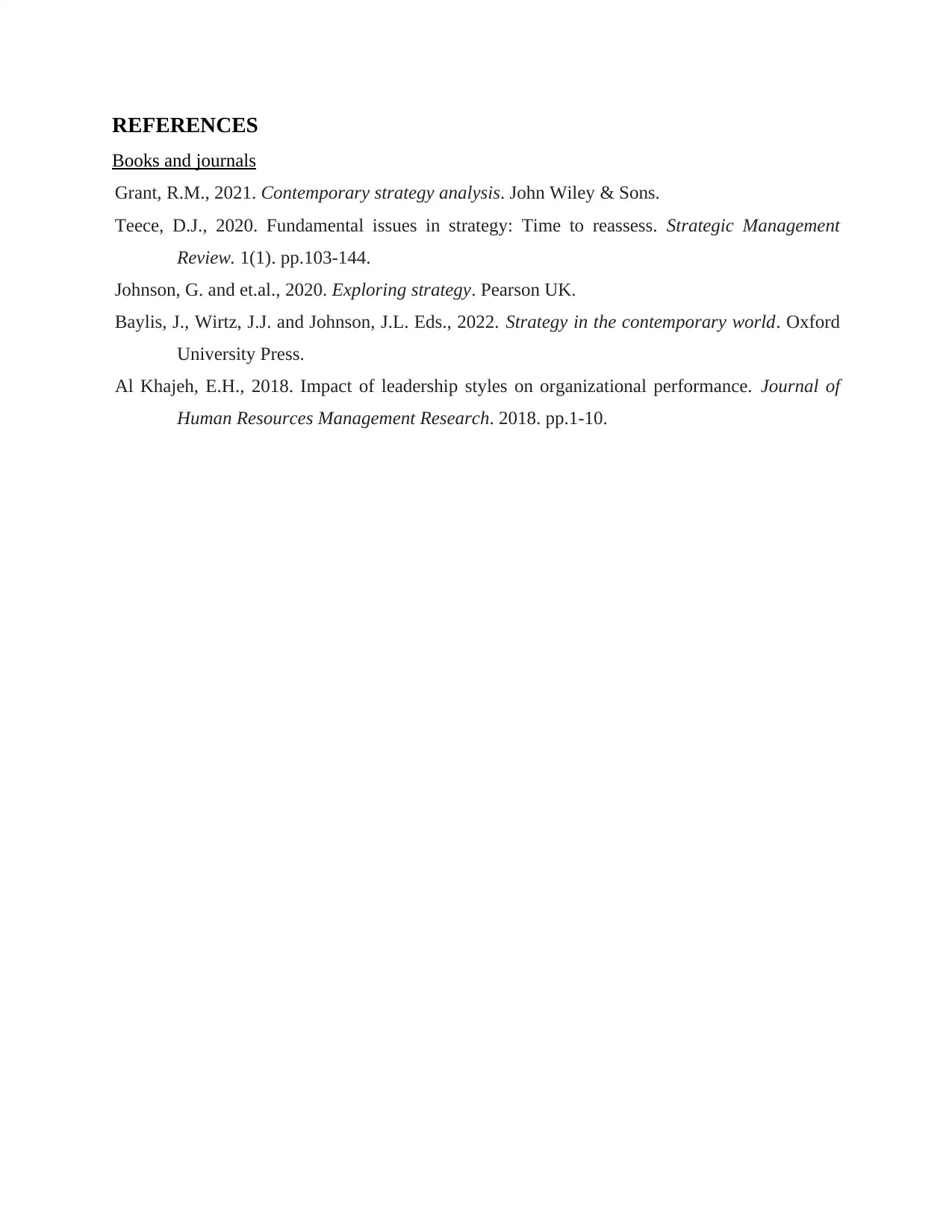
REFERENCES
Books and journals
Grant, R.M., 2021. Contemporary strategy analysis. John Wiley & Sons.
Teece, D.J., 2020. Fundamental issues in strategy: Time to reassess. Strategic Management
Review. 1(1). pp.103-144.
Johnson, G. and et.al., 2020. Exploring strategy. Pearson UK.
Baylis, J., Wirtz, J.J. and Johnson, J.L. Eds., 2022. Strategy in the contemporary world. Oxford
University Press.
Al Khajeh, E.H., 2018. Impact of leadership styles on organizational performance. Journal of
Human Resources Management Research. 2018. pp.1-10.
Books and journals
Grant, R.M., 2021. Contemporary strategy analysis. John Wiley & Sons.
Teece, D.J., 2020. Fundamental issues in strategy: Time to reassess. Strategic Management
Review. 1(1). pp.103-144.
Johnson, G. and et.al., 2020. Exploring strategy. Pearson UK.
Baylis, J., Wirtz, J.J. and Johnson, J.L. Eds., 2022. Strategy in the contemporary world. Oxford
University Press.
Al Khajeh, E.H., 2018. Impact of leadership styles on organizational performance. Journal of
Human Resources Management Research. 2018. pp.1-10.
1 out of 11
Related Documents
Your All-in-One AI-Powered Toolkit for Academic Success.
+13062052269
info@desklib.com
Available 24*7 on WhatsApp / Email
![[object Object]](/_next/static/media/star-bottom.7253800d.svg)
Unlock your academic potential
© 2024 | Zucol Services PVT LTD | All rights reserved.





